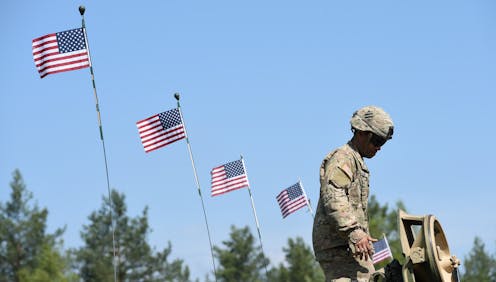
American troops are heading to Eastern Europe in the latest countermove by the U.S. to Russia’s military buildup on the country’s border with Ukraine.
The development, announced on Feb. 2, 2022, will see around 3,000 additional U.S. service personnel deployed to NATO member states Germany, Poland and Romania.
U.S. officials framed the move as one that would reassure countries in the NATO military alliance of U.S. support in the face of a possible invasion of Ukraine, which is not a member. But it is likely to anger President Vladimir Putin, who has demanded that NATO pull back troops from Eastern European countries that were once members of the Soviet Union. Putin has accused the West of ignoring Russia’s security concerns and trying to lure the country into a war.
Behind the rhetoric and troop movement is a very real – and complex – crisis. The Conversation’s bank of experts has been on hand to explain what is at stake, and why Ukraine has become a flashpoint between Russia and the West.
1. What it means to have US boots on the ground
The deployment of thousands of American troops to Eastern Europe wasn’t unexpected. The Pentagon had already said that it was prepared to send up to 8,500 additional members of its armed services to the region.
It marks a reversal of a trend in Europe that has seen America’s military presence dwindle over the past few decades, say Michael Allen of Boise State University and two scholars from Kansas State University, Carla Martinez Machain and Michael Flynn.
The three scholars note that U.S. troop numbers in Europe stood at a high of over 400,000 in the 1950s. But this dropped sharply after the fall of the Soviet Union in the early 1990s.

In the post-Soviet era, U.S. troop presence in Europe has been a delicate matter, the scholars note: “The U.S. and Russia have historically been cautious in not placing troops in places that would be considered a provocation. They generally avoid each other’s sphere of influence, even when responding to the other’s deployments. Yet the NATO allies in Eastern Europe, many of which were once Soviet satellite states, provide a gray area that both the U.S. and Russia may view as within their own sphere of influence.”
2. What it means to be a NATO member
The reason U.S. troops are heading to Germany, Poland and Romania, and not to Ukraine itself, is that the former Soviet country isn’t a member of NATO. As Alastair Kocho-Williams at Clarkson University writes, this isn’t out of a lack of desire on Ukraine’s part.
“Membership with NATO would significantly increase Ukraine’s international military backing, allowing for NATO military action within Ukraine and alongside members of its military. This guarantee of military might would act as a firm deterrent to Russian aggression,” Kocho-Williams writes.
In fact, NATO’s principle of “collective defense” – under which an attack on one member is considered an attack on all – is, the U.S. says, the very reason American troops are heading to Poland and Romania. It is out of the NATO commitment to protect members – the implication being that an invasion of Ukraine could possibly mean that NATO states bordering Russia could be next.
But Kocho-Williams cautions that allowing Ukraine to join the military alliance now may pose a problem. “The threat of an imminent conflict between Ukraine and Russia would commit NATO to take military action against Russia,” he writes.
Read more: What's NATO, and why does Ukraine want to join?
3. How the Russian media might view this troop move
The U.S. stated aim in deploying troops to Eastern Europe – to reassure NATO members – was reported faithfully by the American media. It is unlikely that Russian newspapers and TV news broadcasts will present it in the same way.
Cynthia Hooper at College of the Holy Cross says that the Russian media have portrayed the U.S. as being “hysterical” in its insistence that Putin is hell-bent on invasion. Writes Hooper, “Joe Biden, Russian reporters claim, is building up a false sense of threat from Moscow to deflect attention away from domestic problems.”
Whether the Russian public is buying this line from state-controlled media is, however, another matter. For many, there are bigger things to worry about. Hooper quotes a Russian friend who told her that people “are sick and tired of those endless political TV shows about the Ukraine; they are absolutely indifferent to international issues.”
Read more: It's just a 'panic attack' – Russian media blames US for escalating Ukraine crisis
4. Will deployment deter Putin?
The question is whether the U.S. troop buildup in Eastern Europe will succeed where international agreements have failed; will it deter Putin from transgressing Ukraine’s border?
In 2014, Russia annexed the Crimean peninsula. It was an illegal military land grab – and one that contravened the Budapest Memorandum, a 1994 commitment in which Russia, the U.S. and the U.K. pledged to “respect the independence and sovereignty and the existing borders of Ukraine.”
Part of the the problem, as Lee Feinstein of Indiana University and Mariana Budjeryn at Harvard Kennedy School note, is that the memorandum is not legally binding. Even if it were, it might not have been enough to stay Putin’s hand.
“International law matters, but it does not determine what states do. Strong deterrence, diplomacy and international solidarity can influence Russian decision-making. … Ultimately, however, the de-escalation decision is Russia’s to make,” Feinstein and Budjeryn write. All the U.S. can do is make clear to the Kremlin the consequences of its actions.
This article was originally published on The Conversation. Read the original article.







